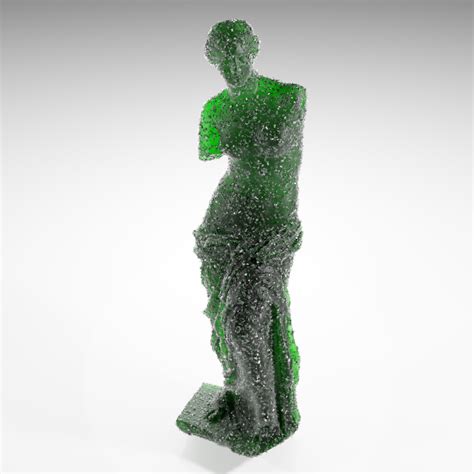The Venus de Milo, an iconic symbol of ancient Greek art, has captivated audiences since its discovery in 1820 on the island of Milos. This masterpiece, believed to represent Aphrodite, the Greek goddess of love and beauty, stands as a testament to the artistic prowess of the Hellenistic period. With its intricate design and graceful form, the Venus de Milo continues to be celebrated for its artistic and cultural significance. Over the centuries, it has undergone various restoration efforts, each revealing more about its storied past. Today, this timeless sculpture is prominently displayed at the Louvre Museum in Paris, where it continues to inspire awe and admiration from millions of visitors worldwide.
gamesfats.com will guide you through an in-depth exploration of this topic.
1. Historical Background and Discovery of Venus de Milo
The Venus de Milo was discovered on April 8, 1820, by a farmer named Yorgos Kentrotas on the island of Milos, part of the Cyclades group in the Aegean Sea. Unearthed in a hidden niche within the ancient city ruins, the statue was found in pieces, including its torso and several other fragments. French naval officer Olivier Voutier, who was present during the discovery, recognized its artistic value and informed the French authorities. Subsequently, the statue was acquired by the Marquis de Rivière, who presented it to King Louis XVIII of France.
Initially believed to be a representation of Aphrodite, the goddess of love and beauty, the Venus de Milo dates back to approximately 130-100 BC, during the late Hellenistic period. Its creator remains unknown, though some suggest it could be the work of Alexandros of Antioch. The statue’s graceful form and intricate detailing highlight the artistic excellence of its era. Today, the Venus de Milo is considered one of the most significant and celebrated sculptures from ancient Greece, symbolizing the enduring legacy of classical art.

2. Artistic Features and Design of the Sculpture
The Venus de Milo is renowned for its exquisite artistic features and intricate design, epitomizing the aesthetic ideals of the Hellenistic period. Standing at over 6 feet tall, the statue is crafted from Parian marble, known for its fine quality and translucence, which adds to the sculpture’s lifelike appearance. The statue depicts a gracefully poised female figure, believed to be Aphrodite, the goddess of love and beauty.
One of the most striking features of the Venus de Milo is its pose. The figure’s upper body is slightly twisted, creating a dynamic sense of movement and fluidity. The drapery of the lower half of the statue is meticulously carved, clinging to the figure’s form in delicate folds that suggest both weight and transparency. The texture and detail of the fabric contrast with the smooth, idealized representation of the skin, highlighting the sculptor’s skill.
Although the arms of the statue are missing, this has not detracted from its allure; rather, it has added an element of mystery and intrigue. The Venus de Milo’s serene expression and balanced proportions embody the classical Greek ideals of harmony and beauty, making it a timeless masterpiece admired by art enthusiasts worldwide.

3. The Significance of Venus de Milo in Ancient Greek Culture
The Venus de Milo holds profound significance in ancient Greek culture, representing the artistic and cultural ideals of the Hellenistic period. As a depiction of Aphrodite, the goddess of love and beauty, the statue embodies the Greek emphasis on divine beauty and perfection. Aphrodite was a central figure in Greek mythology, symbolizing not only physical beauty but also love, fertility, and the generative forces of nature. The statue’s portrayal of Aphrodite thus reflects these values, making it a powerful cultural artifact.
In the context of ancient Greek society, sculptures like the Venus de Milo served both religious and aesthetic purposes. They were often placed in temples, public spaces, and sanctuaries, serving as objects of veneration and symbols of civic pride. The meticulous craftsmanship and idealized forms found in the Venus de Milo illustrate the Greek pursuit of arete, or excellence, in art and life.
Moreover, the Venus de Milo highlights the Greek mastery of marble carving, showcasing their advanced techniques and understanding of human anatomy. The statue’s dynamic pose and realistic drapery exemplify the artistic innovations of the Hellenistic period, which sought to depict more naturalistic and expressive forms. Thus, the Venus de Milo is not just a representation of a goddess but a testament to the artistic and cultural achievements of ancient Greece, continuing to influence and inspi

4. Restoration Efforts and Challenges Over the Years
The restoration efforts and challenges faced by the Venus de Milo over the years have been significant, given the statue’s fragmented discovery and the delicate nature of its material. When the statue was first found in 1820, it was in several pieces, including the torso and various other fragments, which presented immediate challenges for restoration. Early efforts focused on stabilizing the statue and assembling the main fragments to restore its overall form without altering its original integrity.
One of the most notable challenges has been the statue’s missing arms. Various theories and reconstructions have been proposed, but there remains no consensus on their original positions or actions. Some suggest the arms were broken before or during its unearthing, adding an element of mystery and complicating restoration efforts. The absence of definitive evidence has led conservators to maintain the statue in its current state, focusing on preserving its existing form rather than speculative reconstructions.
Another challenge is the ongoing need to protect the marble from environmental factors, such as humidity and pollution, which can cause deterioration. Advances in conservation techniques have allowed for more effective preservation measures, such as climate control and protective coatings. Despite these challenges, the Venus de Milo remains a remarkably well-preserved example of Hellenistic sculpture, its fragmented beauty continuing to captivate and intrigue both sch

5. The Sculpture’s Impact on Modern Art and Culture
The Venus de Milo has had a profound impact on modern art and culture, symbolizing classical beauty and artistic excellence. Since its discovery, the statue has inspired countless artists, sculptors, and designers, who have drawn from its harmonious proportions and elegant form. The Venus de Milo has become an iconic representation of idealized beauty, influencing the aesthetics of various art movements, including Neoclassicism and Romanticism.
In popular culture, the statue’s image has been widely reproduced and referenced, from fashion and advertising to literature and film. Its enigmatic allure, partly due to its missing arms, has made it a subject of fascination and speculation, contributing to its enduring mystique. The Venus de Milo’s presence in the Louvre Museum has also cemented its status as a cultural icon, attracting millions of visitors annually and playing a key role in the museum’s identity.
Overall, the Venus de Milo continues to inspire and captivate, serving as a timeless exemplar of artistic achievement and a testament to the enduring legacy of ancient Greek art in contemporary society.

6. Current Location and Display at the Louvre Museum
The Venus de Milo currently resides in the Louvre Museum in Paris, where it has been displayed since 1821. Positioned prominently in the museum’s Galerie des Antiques, the statue attracts millions of visitors each year, who come to admire its graceful beauty and historical significance. The Louvre, renowned for its extensive collection of art and antiquities, provides an ideal setting for this masterpiece of ancient Greek sculpture.
The statue is carefully situated in a spacious, well-lit area that allows visitors to view it from multiple angles, appreciating its intricate details and dynamic form. The display is designed to highlight the statue’s artistry while preserving its delicate marble structure. Informative plaques and multimedia presentations accompany the exhibit, offering insights into the Venus de Milo’s history, artistic features, and cultural importance.
The Louvre’s commitment to preserving and showcasing the Venus de Milo ensures that this iconic sculpture remains accessible to the public, continuing to inspire awe and admiration. Its presence in one of the world’s most prestigious museums underscores its status as a timeless work of art and a key piece of cultural heritage.

7. Interesting Facts and Myths Surrounding Venus de Milo
The Venus de Milo is surrounded by a wealth of interesting facts and myths that contribute to its enduring mystique. One of the most intriguing aspects is the uncertainty surrounding its missing arms. Various theories propose different poses and attributes, but no definitive evidence has been found. This enigma has led to numerous artistic and scholarly debates, adding to the statue’s allure.
Another fascinating fact is the statue’s name. Although commonly known as the “Venus de Milo,” it is actually a modern designation. The statue was originally called “Aphrodite of Milos” after its discovery on the island of Milos. The name “Venus” was later adopted, reflecting the Roman equivalent of the Greek goddess Aphrodite.
Mythology also surrounds the statue’s origins. Some legends suggest that the Venus de Milo was created by the renowned sculptor Praxiteles, though this claim lacks historical support. Additionally, the statue’s discovery itself is shrouded in romanticized accounts, including stories of hidden treasure and ancient curses.
These myths and intriguing facts have cemented the Venus de Milo’s status as a cultural icon, captivating the imagination of historians, artists, and the public alike.

The Venus de Milo stands as a timeless symbol of ancient Greek artistry and beauty. Its graceful form, combined with the mysteries surrounding its origins and restoration, continues to captivate and inspire. Displayed prominently at the Louvre Museum, this iconic sculpture not only reflects the artistic achievements of the Hellenistic period but also endures as a profound influence on modern art and culture.
gamesfats.com

